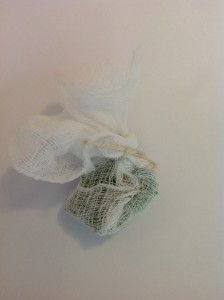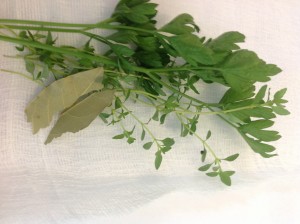 Almost any fish, fowl, or meat can develop inherent complexity and enriched flavor if you marinade before you cook. This concept works extremely well for us, because we can create flavor without consequence. We marinate until the fish or chicken is softened and the flavor is absorbed, then scrap or wash off the spices. We can go further and cook the fish or chicken in a Mirepoix or Softrito, adding additional flavor, and then removing the cooked mirepoix from the fish or chicken before serving.
Almost any fish, fowl, or meat can develop inherent complexity and enriched flavor if you marinade before you cook. This concept works extremely well for us, because we can create flavor without consequence. We marinate until the fish or chicken is softened and the flavor is absorbed, then scrap or wash off the spices. We can go further and cook the fish or chicken in a Mirepoix or Softrito, adding additional flavor, and then removing the cooked mirepoix from the fish or chicken before serving.
Making a marinate is as simple as using an acidic ingredient such as lemon juice, wine or yogurt, and then flavoring that with oil and spices. It’s the acidic ingredient that softens the food and allows it to absorb the flavors.
Maricel Presilla in Gran Cocina Latina: the food of Latin American (2012) says that being Cuban she marinates any fish, fowl, or meat the minute she brings them home. For Latin cooks this is the adobo, the first layer. Presilla uses the same one for everything, meat, pork, chicken, fish, turkey, even a whole pig!
Adobo, Maricel Presilla
Crush a blend of seasonings, mostly allspice & garlic (I add fresh or dried herbs such as thyme and basil], in a mortar with a pestle and add the juice of bitter orange for moisture and tang and acidity. When I make her adobo, I don’t have bitter oranges readily available so I use a regular Florida orange with a good helping of its grated rind and fresh or dried green herbs. Rub this into whatever you plan to serve. Put it into a covered nonreactive bowl, or into a plastic sealable bag, and put into the refrigerator.
Marinating fish will add flavor, but it should be brief. More than 30 minutes of an acidic marinate and the acid will denature the protein and the fish will become mushy. So 30 minutes is enough already! Ah well, unless we talking about a dense fish such as tuna or swordfish, then you can marinate up to 8 hours. Two hours in the refrigerator for chicken is usually enough.
You’ll marinate and then remove the fish or chicken from the liquid and scrape off any clinging pieces, even rinse briefly under a shower of water. Just to be sure particles don’t adhere. Then sauté, bake, or poach. The flavors will persist!
Here’s a website on marinating: http://startcooking.com/marinating-101-an-introduction-to-marinating-beef-chicken-and-fish.
After the marinade (I usually don’t use the marinade in the cooking process unless it’s boiled first) I cook the chicken or the fish in olive oil with a combination of onions and garlic, first simmered gently in olive oil until softened and then adding other aromatic vegetables such as diced celery and carrots, followed by liquids such as white or red wine or tomatoes with a bouquet garni added. This is a mixture I use for everything, soups, stews, etc. We’re going to cook in the mixture and then strain it so that we don’t leave any bits behind to fall into the airway or hide away in the crevices of the throat.
Here’s what Wikipedia has to say about my combination which is the French mirepoix: “Similar combinations of vegetables are known as sofrito in Spanish, refogado (braised onions, garlic and tomato) in Portuguese, soffritto (onions, garlic and celery) in Italian, Suppengrün (soup greens) in German and soepgroente in the Netherlands (usually purchased in bundles and consisting of a leek, a carrot and piece of celeriac), holy trinity (onions, celery and bell peppers) in Cajun and Creole cooking, and włoszczyzna in Polish, and typically consists of carrots, parsnips, parsley root, celery root, leeks, cabbage leaves, and sometimes celery and flat-leaf parsley.”
My go-to combination is the following:
Mirepoix or Softrito
1-2 tablespoons olive oil
1 cup diced onion
1 cup diced celery
½ cup diced carrot
2 cloves of garlic
1 bouquet garni (1/2 bay leaf, 2 sprigs of parsley, ½ teaspoon dried thyme tied in a piece of washed cheese cloth)
Heat the olive oil in a medium sized frying pan. Add 1 tablespoon olive oil and the onions. Simmer until the onions are translucent (5 minutes); add the celery, carrot, garlic and bouquet garni. Continue simmering for 10 more minutes/
As I said, I use this combination for almost everything I cook: soups, stews, chicken, fish, marinades, so I often double or triple the recipe and then freeze the cooked mirepoix by the tablespoon in an ice cube tray. When I need them, I pop one or two out of the ice cube tray and simmer it slowly in a tablespoon of olive oil and voila! I have a quick start to a meal.
Firm White Fish*
2 servings
Defrost two fish fillets according to package directions (in a bowl of cold water)
Marinate them 30 minutes in the marinade described above
Remove from marinate and rinse gently under cold water; pat dry
Add 1 tablespoon of olive oil to medium size frying pan
Add Mirepoix above, simmering if frozen until melted and heated through
Add fish. Simmer 3 to 5 minutes on one side (simmer means that you can barely see little bubbles plopping up.)
Turn fish; simmer again on other side 2 to 4 minutes
Remove fish; scrap any clinging herbs from fish
If herbs cling, rinse briefly with hot water
Serve.
*I used frozen Hake from Costco



 e
e 






























